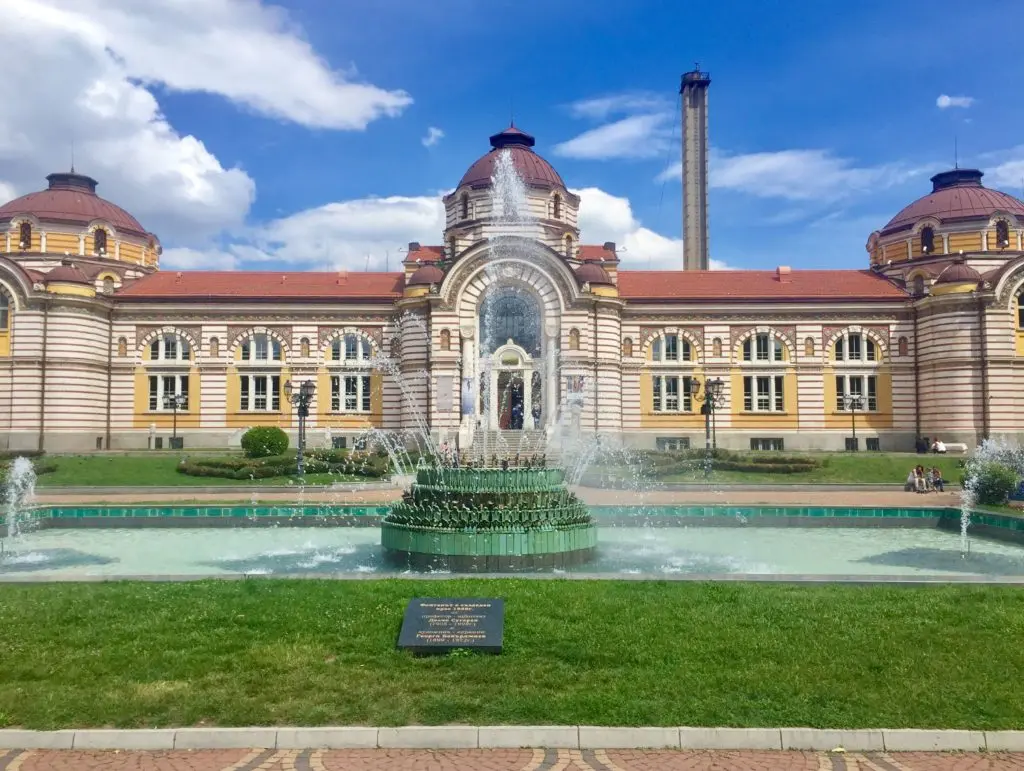The Balkans are a place where Mediterranean, Ottoman, and Austro-Hungarian tastes come together. It’s a culinary treasure waiting to be found. Balkan cuisine is full of diverse dishes that will make your taste buds happy.

At Ajdinis Travel, we focus on making unforgettable food experiences. If you want to try traditional Balkan recipes or see what local food is like, we’re here to help. For more on our Balkan trip packages, email us at info@ajdinistravel.com or call +38972641066.
Key Takeaways
- Discover the unique blend of Mediterranean, Ottoman, and Austro-Hungarian influences in Balkan cuisine.
- Explore traditional Balkan recipes with Ajdinis Travel’s culinary experiences.
- Contact Ajdinis Travel for personalized Balkan trip packages.
- Indulge in the local food scene with expert guidance.
- Experience the rich gastronomic heritage of the Balkans.
The Rich Heritage of Balkan Cuisine
The Balkans are a region filled with history and cultural diversity. They have a rich culinary heritage shaped by centuries of influences. This diversity shows in the wide range of ingredients, cooking techniques, and dishes found in Balkan cuisine.
Historical Influences on Balkan Food
Balkan cuisine has been shaped by many historical empires and cultures. The Ottoman Empire, Austria-Hungary, and the Mediterranean have all left their mark. They introduced new ingredients and cooking methods, like spices, grilling meats, and making pastries.
The Ottoman Empire’s legacy is seen in dishes like Ćevapi and Burek, which are now beloved across the Balkans. The influence of Austria-Hungary is also clear in the region’s pastry-making traditions.
Regional Variations Across the Balkans
The Balkans are not a single entity; each region has its own unique culinary traditions. From the hearty meat dishes of the north to the seafood-rich cuisine of the Adriatic coast, every area has its own flavor profile.
| Region | Characteristic Dish | Main Ingredients |
|---|---|---|
| Northern Balkans | Ćevapi | Minced meat, spices |
| Adriatic Coast | Grilled Fish | Fresh fish, olive oil, herbs |
| Eastern Balkans | Burek | Phyllo dough, meat or cheese filling |
This regional diversity makes the culinary landscape of the Balkans rich and varied. It offers a wide range of options for those eager to explore its cuisine.
Essential Ingredients in Traditional Balkan Cooking
In traditional Balkan recipes, the choice of ingredients is key. They make the dishes both tasty and healthy. The region’s food focuses on local ingredients and traditional cooking methods.
Fresh Produce and Herbs
Fresh produce and herbs are the heart of Balkan cuisine. Tomatoes, peppers, and cucumbers are found in many dishes. Herbs like parsley, dill, and mint add freshness and depth.

Meats and Dairy Products
Meats and dairy are vital in Balkan cooking. Lamb, beef, and pork are grilled or slow-cooked. Dairy items like kajmak, a creamy cheese, and yogurt add richness and tanginess.
Spices and Seasonings
Spices and seasonings are essential in Balkan cooking. They add complexity and warmth. Common spices include paprika, garlic, and black pepper.
These spices, mixed with herbs, create Balkan’s unique flavors.
10 Must-Try Balkan Main Dishes
Exploring Balkan cuisine means trying certain main dishes. These dishes are not just tasty but also show the region’s rich food heritage. Here, we’ll guide you through the top 10 Balkan main dishes you must try.
Ćevapi: The Beloved Balkan Sausage
Ćevapi is a key dish in Balkan food, loved in places like Bosnia and Serbia. These small, grilled sausages are served with flatbread, somun, and onions. Ćevapi are a must-try in the Balkans, showing a cherished culinary tradition.
Burek: Flaky Pastry Perfection
Burek is a favorite Balkan dish, filled with meat, cheese, or veggies. It’s great as a main or snack. The flaky pastry layers show Balkan cooks’ skill and patience.
Sarma: Stuffed Cabbage Rolls
Sarma is a hearty dish with cabbage leaves stuffed with meat and rice. It’s slow-cooked to perfection. This dish shows Balkan cuisine’s ability to make tasty meals from simple ingredients.
Pljeskavica: The Balkan Burger
Pljeskavica is like a Balkan burger, made from ground meats and grilled. It’s served with flatbread and toppings like kajmak and onions. Pljeskavica is a favorite among locals and visitors.
Moussaka: Layered Eggplant Delight
Moussaka is a rich dish with eggplant, meat, and creamy béchamel sauce. It’s a Balkan staple, often served at special events. Its mix of textures and flavors makes it a highlight in Balkan cuisine.
These 10 dishes give a taste of Balkan culinary diversity and richness. From grilled meats to layered pastries, there’s something for everyone. Trying these dishes is a great way to enjoy Balkan culinary traditions.
- Ćevapi
- Burek
- Sarma
- Pljeskavica
- Moussaka
- Other 5 dishes to be included in the list
Delicious Balkan Appetizers and Side Dishes
Balkan cuisine is full of tasty appetizers and side dishes. These dishes are more than just sides; they’re a big part of Balkan meals. They bring a variety of tastes and textures that make every bite exciting.

Ajvar: The Versatile Red Pepper Spread
Ajvar is a key part of Balkan food, made from roasted red peppers, garlic, and eggplant. It’s great on its own or with other dishes. The smoky taste comes from roasting the peppers over an open flame. Ajvar’s rich flavor makes it a hit with both locals and visitors.
“Ajvar is more than just a condiment; it’s a taste of the Balkans’ rich culinary heritage.”
Shopska Salad: Fresh and Vibrant
Shopska salad is a fresh mix of tomatoes, cucumbers, onions, and feta cheese. It’s made with locally sourced ingredients for a bright taste. This salad shows off Balkan cuisine’s love for simple, fresh flavors. The mix of crunchy veggies and tangy feta is a perfect example of the region’s flavor preferences.
| Ingredient | Quantity | Preparation |
|---|---|---|
| Tomatoes | 3 | Diced |
| Cucumbers | 2 | peeled and diced |
| Feta Cheese | 1 cup | crumbled |
Kajmak: Creamy Dairy Delicacy
Kajmak is a creamy dairy product, like a mix of cheese and butter. It’s made by simmering milk and skimming off the cream. Kajmak is a Balkan favorite, enjoyed on its own or in dishes. Its creamy texture and flavor make it a prized ingredient in Balkan cooking.
Prebranac: Traditional Bean Dish
Prebranac is a hearty bean dish cooked with onions and sometimes bacon or sausage. It’s a comforting side dish loved in the Balkans. The slow cooking blends the flavors, creating a rich taste. Prebranac shows how Balkans make nourishing meals from simple ingredients.
In conclusion, Balkan appetizers and side dishes like Ajvar, Shopska salad, Kajmak, and Prebranac give a peek into the region’s rich food heritage. These dishes are not only tasty but also show the cultural and culinary traditions of the Balkans.
Sweet Treats and Desserts of the Balkans
The Balkans are filled with sweet delights that show off the region’s rich traditions. Desserts here are a mix of tradition and creativity. From Baklava to Tulumba, these treats will delight your taste buds.

Layers of Sweetness: Baklava
Baklava is a famous Balkan dessert. It has layers of flaky pastry, nuts, and honey. This sweet treat is loved at celebrations across the region. The mix of crunchy nuts and sweet honey in Baklava is unforgettable.
Fried Dough Pastry: Tulumba
Tulumba is a fried dough pastry soaked in syrup. It’s a sweet favorite in the Balkans, enjoyed at family gatherings. Its crispy outside and soft inside, with sweet syrup, make it a hit.
Balkan Crepes: Palačinke
Palačinke, or Balkan crepes, are loved for their versatility. They can be filled with Nutella, fruit, or cheese. These thin crepes are enjoyed by all ages in the Balkans. They show the region’s culinary creativity.
Turkish Delight: Lokum
Lokum, or Turkish Delight, is a classic Balkan dessert. It’s made from sugar, cornstarch, and fruit juice. Flavored with rosewater or lemon, Lokum is a refreshing treat. It’s often given as a sign of hospitality.
| Dessert | Description | Region |
|---|---|---|
| Baklava | Layered pastry with nuts and honey | Throughout the Balkans |
| Tulumba | Fried dough pastry soaked in syrup | Popular in Balkan countries |
| Palačinke | Thin crepes with various fillings | Found in many Balkan cultures |
| Lokum | Gel-like confection flavored with rosewater or lemon | Common in Balkan and Turkish cuisine |
The Cultural Significance of Balkan Cuisine in Daily Life
In the Balkans, food is more than just something to eat. It’s a way to connect people and build strong community ties. Balkan cuisine is deeply rooted in the region’s rich history and culture.
Family Traditions and Celebrations
Balkan cuisine is central to family traditions and celebrations. Traditional dishes are made for big events like weddings and holidays. These dishes help keep the region’s Balkan culinary traditions alive.
For instance, during winter holidays, families come together to make sarma (stuffed cabbage rolls) and prebranac (traditional bean dish). These meals are more than just food; they represent unity and the passing down of cultural heritage.
Hospitality and Food Customs
Hospitality is key in Balkan culture, and food is at the heart of it. When guests arrive, they’re welcomed with traditional dishes and drinks. This tradition is a big part of Balkan food history.
| Occasion | Traditional Dish | Significance |
|---|---|---|
| Weddings | Ćevapi | Celebratory feast |
| Religious Festivals | Sarma | Family gathering |
| Guest Reception | Rakija and Ajvar | Hospitality |

The table shows how different events are tied to traditional Balkan dishes. It highlights the importance of food in daily life and celebrations.
Experiencing Authentic Balkan Cuisine Through Travel
Start a food adventure in the Balkans, where every meal has a story. The area’s rich food history is a key part of any trip. It offers many ways to dive into local culture.

Food Markets and Street Food Experiences
Visiting lively food markets and trying street food is a great way to taste authentic Balkan dishes. You’ll find everything from savory Ćevapi to sweet Baklava. Walking through the stalls, you’ll enjoy the sights, smells, and tastes of the region.
Traditional Restaurants and Kafanas
For a real taste of Balkan food, go to local restaurants or Kafanas. These places serve big, homemade meals that show off the best of Balkan cooking. Try Sarma or Pljeskavica and pair it with local wine or Rakija.
Culinary Tours with Ajdinis Travel
At Ajdinis Travel, we have customized food-focused itineraries. These tours let you connect with local people and enjoy real experiences. You’ll learn about the region’s food culture, from ingredients to cooking methods.
Customized Food-Focused Itineraries
We work with you to make a trip plan that fits your food interests. Whether you want to try street food, visit traditional restaurants, or explore markets, we’ll help you.
Local Connections and Authentic Experiences
What makes us special is our focus on authentic experiences. Our tours let you meet local chefs, farmers, and artisans. This way, you’ll really understand the region’s food heritage.
As
“Food is the ingredient that binds us together.”
At Ajdinis Travel, we think trying local food is key to exploring the Balkans. Let us help plan your food journey and discover the rich tastes and traditions of the area.
Balkan Drinks and Beverages
The Balkans are known for their unique drinks, blending tradition with taste. Drinks are key in the Balkan culinary world. They enhance local dishes and make dining special.
Rakija: The Spirit of the Balkans
Rakija is a strong fruit brandy loved by many in the Balkans. It’s made from fruits like plums, grapes, or apricots. Often homemade, Rakija shows hospitality. It’s more than a drink; it’s a tradition and a symbol of community.

Regional Wines and Beers
The Balkans boast a wide variety of wines and beers. From Slovenia’s crisp whites to Bulgaria’s rich reds, there’s something for everyone. Beer lovers will find local lagers and ales.
| Drink | Region | Description |
|---|---|---|
| Rakija | Various | Strong fruit brandy |
| Slovenian Wine | Slovenia | Crisp white wines |
| Bulgarian Red | Bulgaria | Rich red wines |
Traditional Non-Alcoholic Beverages
Not all Balkan drinks have alcohol. Traditional non-alcoholic drinks are just as tasty. From coffee to fruit compotes, these drinks are part of balkan culinary traditions. They’re enjoyed at social events.
Exploring traditional Balkan recipes shows drinks are more than just sides. They’re deeply connected to the region’s food and culture.
Conclusion: Planning Your Balkan Culinary Adventure
As we wrap up our culinary journey through the Balkans, we hope you’re excited to explore. The Balkans offer a world of flavors and traditions. Whether you’re planning a trip or want to try new recipes at home, you’ll find something special.
At Ajdinis Travel, we’re all about creating unforgettable culinary experiences. Our Balkan trip packages let you dive into local culture. You’ll enjoy traditional dishes and vibrant food markets. We want you to experience the authentic flavors of the Balkans and enjoy the region’s warm hospitality.
Ready to learn more about our Balkan trip packages? Contact us to start planning your culinary adventure. We can’t wait to share the richness of Balkan culinary culture with you.
FAQ
What is Balkan cuisine?
Balkan cuisine is a mix of flavors from the region’s history and culture. It’s influenced by the Ottoman Empire, Austria-Hungary, and the Mediterranean.
What are some must-try Balkan dishes?
You should try Ćevapi, Burek, Sarma, Pljeskavica, and Moussaka. These dishes show the region’s cooking skills and offer a variety of tastes and textures.
What are the essential ingredients in traditional Balkan cooking?
Traditional Balkan cooking uses fresh produce, herbs, meats, dairy, and spices. These ingredients add depth and complexity to the dishes.
How can I experience authentic Balkan cuisine?
To taste authentic Balkan cuisine, visit food markets and try street food. Eat at traditional restaurants and Kafanas. Also, take a culinary tour with Ajdinis Travel.
What are some popular Balkan drinks and beverages?
Popular drinks include Rakija, regional wines and beers, and non-alcoholic beverages. These drinks go well with local dishes and show the region’s culture.
How does Balkan cuisine play a role in daily life and cultural celebrations?
Balkan cuisine is key in daily life and celebrations. It shows the importance of family, tradition, and hospitality. Food brings people together in the community.
Can I customize a food-focused itinerary with Ajdinis Travel?
Yes, Ajdinis Travel lets you create a food-focused itinerary. You can connect with local communities and enjoy authentic experiences that fit your interests.
What is the cultural significance of traditional Balkan recipes?
Traditional Balkan recipes are important. They reflect the region’s culture and are tied to family traditions, celebrations, and hospitality. They are a big part of Balkan identity.

















